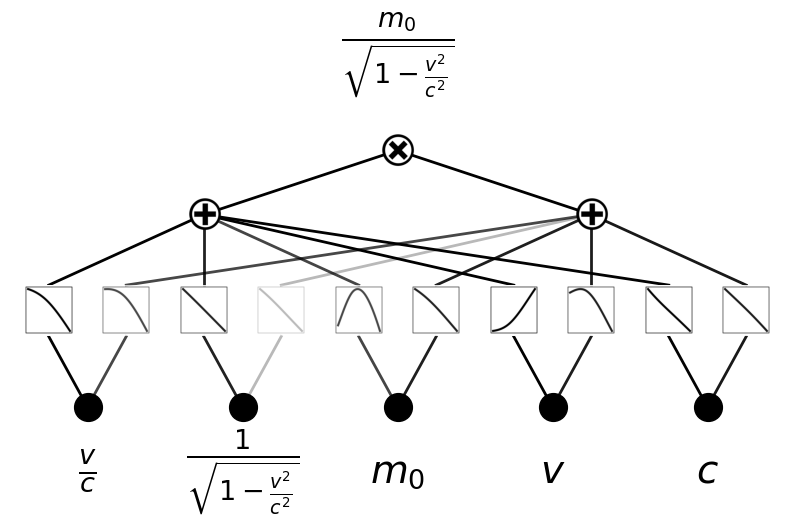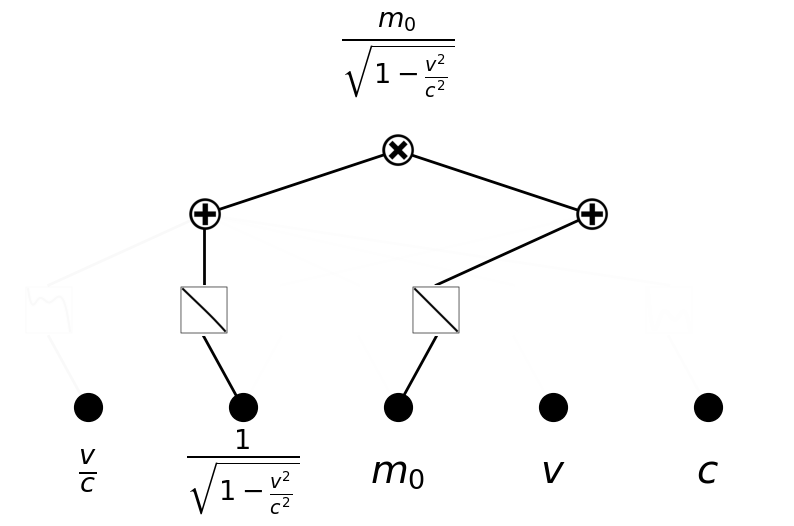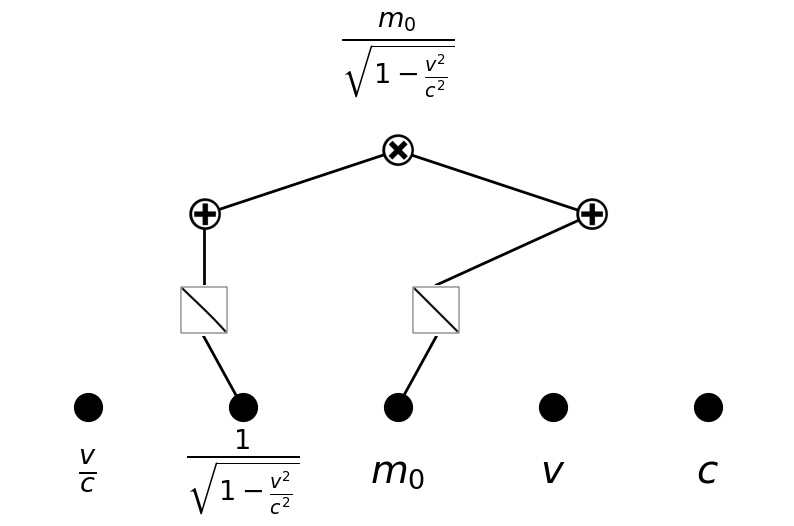Interpretability 8: Adding auxiliary variables
When we do a regression task, it might be good to include auxiliary input variables, even though they might be dependent on other variables. For example, to regress \(m(m_0, v, c)=m_0/\sqrt{1-(v/c)^2}\), it is desirable to include the dimensionaless varabile \(\beta = v/c\) as a separate input variable. If we also know this is a task in relativity, we may also include \(\gamma=1/\sqrt{1-(v/c)^2}\) because \(\gamma\) appears frequently in relativity.
from kan.MultKAN import MultKAN
from sympy import *
from kan.utils import create_dataset, augment_input
import torch
seed = 1
torch.manual_seed(seed)
torch.set_default_dtype(torch.float64)
input_variables = m0, v, c = symbols('m0 v c')
# define auxillary variables
beta = v/c
gamma = 1/sqrt(1-beta**2)
aux_vars = (beta, gamma)
f = lambda x: x[:,[0]]/torch.sqrt(1-x[:,[1]]**2/x[:,[2]]**2)
dataset = create_dataset(f, n_var=3, ranges=[[0,1],[0,0.9],[1.1,2]])
# add auxillary variables
dataset = augment_input(input_variables, aux_vars, dataset)
input_variables = aux_vars + input_variables
model = MultKAN(width=[5,[0,1]], mult_arity=2, grid=3, k=3, seed=seed)
checkpoint directory created: ./model
saving model version 0.0
model(dataset['train_input'])
model.plot(in_vars=input_variables, out_vars=[m0/sqrt(1-v**2/c**2)], scale=1.0, varscale=0.7)

model.fit(dataset, steps=50, lamb=1e-5, lamb_coef=1.0);
| train_loss: 5.13e-04 | test_loss: 6.64e-04 | reg: 3.18e+00 | : 100%|█| 50/50 [00:07<00:00, 7.10it
saving model version 0.1
model.plot(in_vars=input_variables, out_vars=[m0/sqrt(1-v**2/c**2)], scale=1.0, varscale=0.7)

model = model.prune(edge_th=5e-2)
saving model version 0.2
model.plot(in_vars=input_variables, out_vars=[m0/sqrt(1-v**2/c**2)], scale=1.0, varscale=0.7)

model.fit(dataset, steps=100, lamb=0e-3);
| train_loss: 3.15e-06 | test_loss: 1.99e-05 | reg: 2.74e+00 | : 100%|█| 100/100 [00:10<00:00, 9.48
saving model version 0.3
model.auto_symbolic()
fixing (0,0,0) with 0
fixing (0,0,1) with 0
fixing (0,1,0) with x, r2=0.999998976626967, c=1
fixing (0,1,1) with 0
fixing (0,2,0) with 0
fixing (0,2,1) with x, r2=0.9999999998075859, c=1
fixing (0,3,0) with 0
fixing (0,3,1) with 0
fixing (0,4,0) with 0
fixing (0,4,1) with 0
saving model version 0.4
sf = model.symbolic_formula(var=input_variables)[0][0]
sf
\[\displaystyle 1.0 \cdot \left(0.000189505852432992 - \frac{0.817980335069318}{\sqrt{1 - \frac{v^{2}}{c^{2}}}}\right) \left(- 1.22278885546569 m_{0} - 2.33019836537451 \cdot 10^{-7}\right)\]
from kan.utils import ex_round
nsimplify(ex_round(ex_round(ex_round(sf,6),3),3))
\[\displaystyle \frac{m_{0}}{\sqrt{1 - \frac{v^{2}}{c^{2}}}}\]